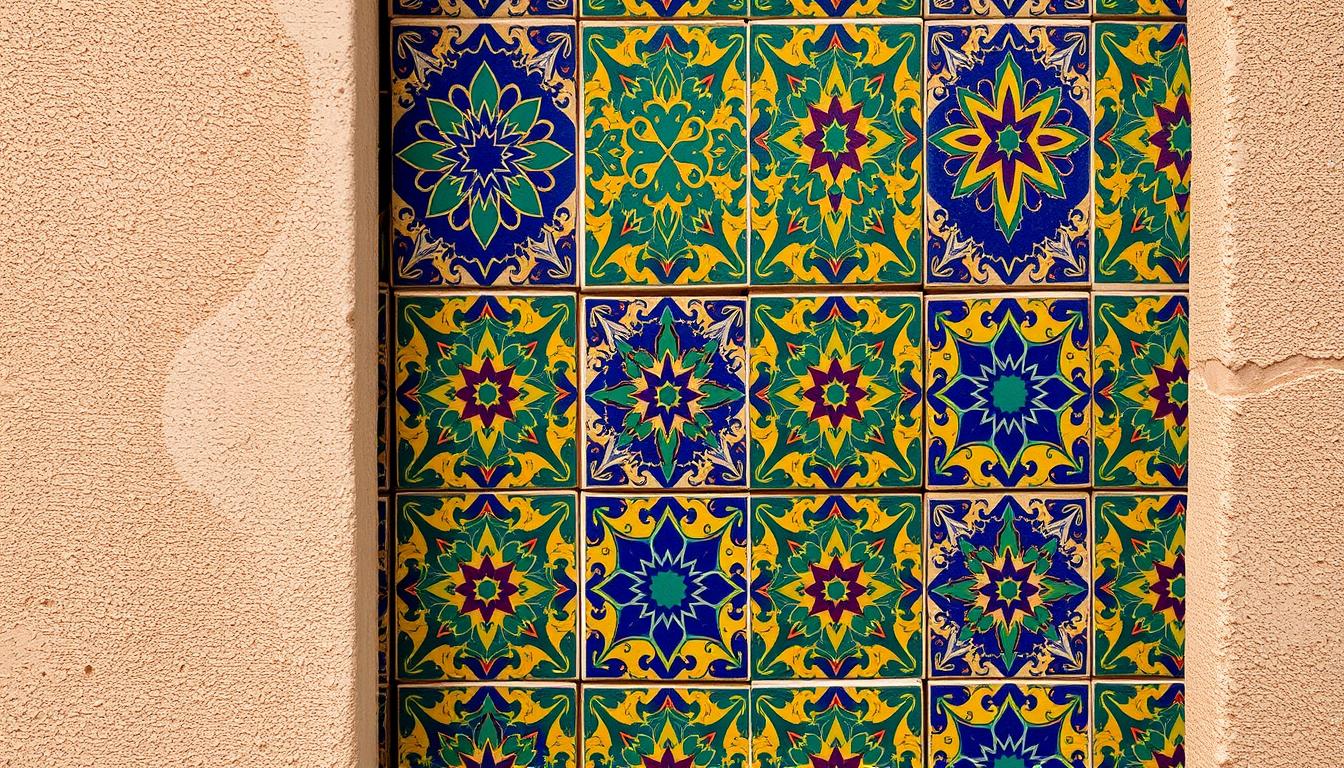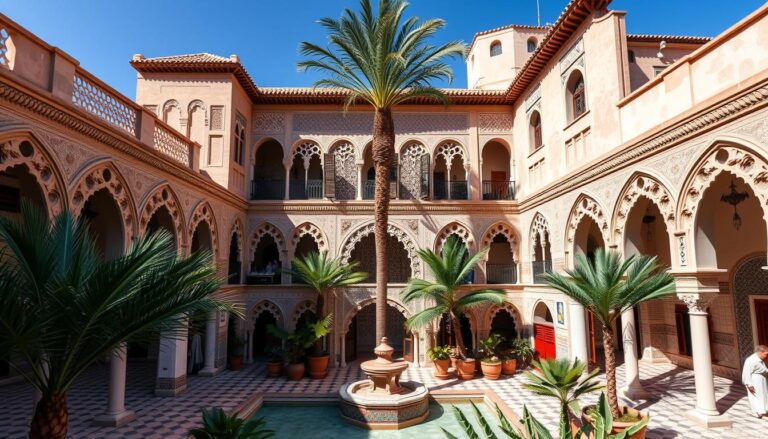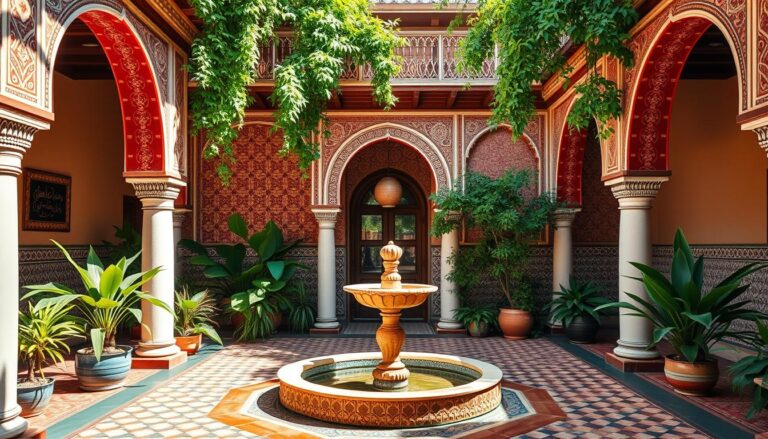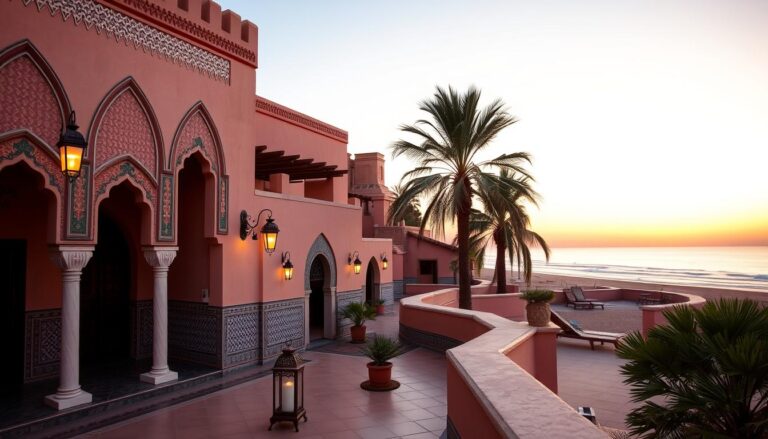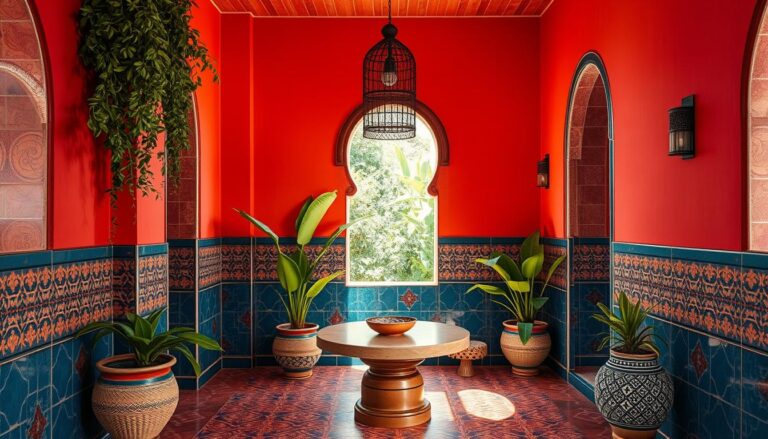Ever wondered about the origins of Zellige tile designs in Moroccan architecture? These designs have a rich history, starting in the 10th century. They have become a key part of Moroccan culture and heritage. Let’s explore the history of these beautiful tiles and why they still enchant us today.
Key Takeaways
- The art of Zellige tile-making in Moroccan architecture originated in the 10th century, initially in white and brown tones imitating Roman mosaics.
- Zellige patterns incorporate basic geometrical shapes following strict mathematical patterns, creating visually stunning designs.
- The color palette of Zellige tiles evolved over centuries, introducing vibrant hues of blue, green, yellow, and red in the 17th century.
- Prominent examples of Zellige can be found in historical sites like the Alhambra Palace in Granada and the Hassan II Mosque in Casablanca.
- The intricate process of Zellige manufacturing requires skilled labor and meticulous attention to detail.
The Exquisite Art of Zellige
Definition and Origins
Zellige is a mosaic tile technique from Morocco’s Moorish heritage. The word “Zellige” comes from “zalij,” meaning “tile” in Arabic. It’s about putting together glazed terracotta tiles in intricate patterns, inspired by Islamic designs.
This art form started in the 10th century. It was a way to mimic Greco-Roman marble mosaics. Moroccan artisans used handcrafted tiles in colors like white, brown, green, blue, yellow, and red.
“Zellige tiles are a true testament to the ingenuity and artistry of Moroccan craftspeople, who have elevated the humble tile into a breathtaking medium for artistic expression.”
Over time, Zellige tiles have changed with Moroccan dynasties. Each dynasty added its own style and techniques. From the 11th century’s geometric patterns to the 14th century’s bright colors, Zellige has amazed the world.
The Evolution of Zellige Across Dynasties
The art of Moroccan Zellige tiles has a long history. It started in the 10th century. Back then, these tiles were only white and brown, influenced by Islamic, Roman, and Byzantine designs.
Later, with the rise of Almoravid, Almohad, and Marinid dynasties (11th-15th centuries), the tiles got brighter. They added blue, green, and yellow to their palette. This made the Moroccan tile art even more beautiful with Islamic geometric patterns and mosaic tile designs.
In the 17th century, red tiles were introduced. This made the Zellige even more stunning. The 20th century brought new glazing techniques, making these tiles even more special.
Today, the traditional zellige techniques are still used in Fez tile workshops. Here, Maallems (master craftsmen) create the Islamic geometric patterns that decorate famous Moroccan architectural masterpieces.
History of zellige tile-making in Moroccan Architecture
Architectural Masterpieces Adorned with Zellige
Zellige tiles are a key part of Moroccan architecture. They decorate walls in palaces, mosques, and fountains. Famous places like the Alhambra Palace and the Medersa el-Attarine in Fez show off their beauty.
Zellige tile-making started in the 10th to 13th centuries. It became more detailed by the 11th century. By the 14th century, it was all over Morocco, Algeria, and Spain.
The Marinid tilework is known for its Arabic inscriptions. These were made using the sgraffito technique. Tlemcen craftsmen also made bright, floral-patterned tiles.
Zellige tiles often feature geometric patterns. Sometimes, they include plant or flower designs. The 14th century saw amazing Zellige art in the Alhambra, Spain.
By the 16th century, Zellige tile-making was mostly found in Morocco. It’s used in mosques, madrasas, palaces, and baths. The Al-Attarine Madrasa in Fez is a great example of Zellige’s beauty.
The Craftsmanship of Zellige Masters
The making of traditional zellige techniques needs a lot of skill and care. The Maallems, or Zellige artisans, play a key role. They learn their craft over years, often from their fathers and teach their sons.
Creating handcrafted Moroccan tiles is a detailed process. It includes mixing clay, shaping tiles, cutting Islamic geometric patterns, and putting together the mosaic tile designs.
Using old tools and sticking to ancient tile-making processes is vital. It keeps the quality and authenticity of Moorish architectural heritage Zellige tiles. This hard work makes sure each tile shows Morocco’s rich culture.
The Role of Maallems and Traditional Techniques
- Zellige-making takes at least ten years of hard training. Skills are passed down from father to son.
- Zellige artisans, or maalems, coat the tiles with colored glaze by hand. This makes each tile unique and beautiful.
- Cities like Fez and Meknes are still big in zellige making in Morocco. Master craftsmen make both old and new designs.
“The Zellige tradition of the family that owns the atelier responsible for producing the Alhambra range started in 1928 with only 10 workers, and now employs 500 workers across 5 ateliers in and around Fez.”
This commitment to keeping the craft true ensures each tile shows Morocco’s rich culture. This makes Zellige tiles a symbol of the amazing skill of these master artisans.
Conclusion
The history of zellige tile-making in Moroccan architecture shows the lasting impact of this craft. It started in the 10th century and is still loved today. Zellige tiles are known for their detailed geometric patterns, bright colors, and natural beauty.
These tiles have become a symbol of Morocco’s architectural heritage. They inspire designers and homeowners worldwide. This shows how zellige tiles have become a beloved part of Moroccan culture.
The Moorish architectural heritage is at the heart of zellige. These handcrafted Moroccan tiles are found in important places like mosques and mausoleums. They also decorate traditional Moroccan houses.
Today, artisans are exploring new colors and patterns in zellige design. This has brought the art into luxury hotels, upscale residences, and commercial spaces around the world. It shows the timeless beauty and cultural importance of zellige tile-making.
The work of Fez tile workshops and conservation initiatives helps keep zellige tile-making alive. This ensures that Islamic geometric tile art will continue to amaze and inspire people for years to come. The story of handcrafted Moroccan tiles is a testament to Morocco’s dedication to its architectural and cultural heritage.
Source Links
- Where to find zellige? photo gallery, history, handmade zellige and mosaic from Morocco
- From Andalusia to the Almohad: A History of Moroccan Zellige Tile – Design Dash
- Zellij – The Prince of Tiles History | Zellij Gallery
- Historic Origins of Zellige Tiles | Paris Tile
- Moorish Tile History and Inspiration – Why Tile
- Beautiful Art of Moroccan Zellige
- Zellij
- Cultural Heritage of Zellij in Moroccan Architecture | Paris Tile
- The beautiful art of Zellige – Artzellige
- Tile blog articles – De Tegel BV
- Zellij Gallery Brings To Life The Ancient Traditions Of Moroccan Tile Making And Design – SuperbCrew
- Zellige, a sacred art of geometry in Palais Faraj
- Exploring the Art of Zellij | La Signature
- What Is Moroccan Zellige Tile? – Marrakeche Crafts
- What is a zellige tile? – Artzellige – Moroccan tiles

The Editorial Team is a passionate group of Morocco enthusiasts dedicated to sharing the beauty, culture, and wonders of this captivating country. With diverse backgrounds and a deep love for travel, we strive to bring you engaging and informative content that inspires your Moroccan adventures. From uncovering hidden gems and sharing local insights to exploring mouthwatering cuisine and showcasing the vibrant lifestyle, our team is committed to providing you with valuable resources and exciting stories that enhance your exploration of Morocco. Join us on this journey as we celebrate the rich heritage and unforgettable experiences that make Morocco truly special.

